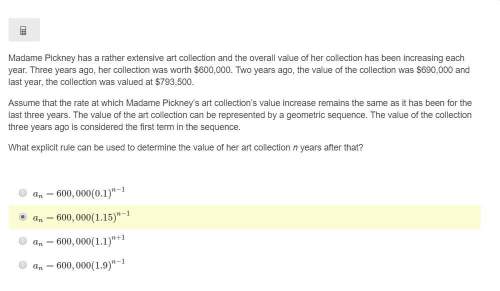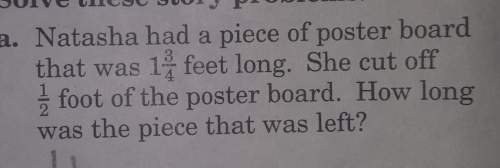
Mathematics, 31.12.2019 12:31 foralways4871
Madame pickney has a rather extensive art collection and the overall value of her collection has been increasing each year. three years ago, her collection was worth $600,000. two years ago, the value of the collection was $690,000 and last year, the collection was valued at $793,500.
assume that the rate at which madame pickney’s art collection’s value increase remains the same as it has been for the last three years. the value of the art collection can be represented by a geometric sequence. the value of the collection three years ago is considered the first term in the sequence.
what explicit rule can be used to determine the value of her art collection n years after that?


Answers: 2


Other questions on the subject: Mathematics

Mathematics, 21.06.2019 20:00, soniah
Pepe and leo deposits money into their savings account at the end of the month the table shows the account balances. if there pattern of savings continue and neither earns interest nor withdraw any of the money , how will the balance compare after a very long time ?
Answers: 1

Mathematics, 21.06.2019 20:00, paulesparsa6
Given the two similar triangles, how do i find the missing length? if a=4, b=5, and b'=7.5 find a'
Answers: 1

Mathematics, 21.06.2019 21:30, shymitch32
Create a graph for the demand for starfish using the following data table: quantity/price of starfish quantity (x axis) of starfish in dozens price (y axis) of starfish per dozen 0 8 2 6 3 5 5 2 7 1 9 0 is the relationship between the price of starfish and the quantity demanded inverse or direct? why? how many dozens of starfish are demanded at a price of five? calculate the slope of the line between the prices of 6 (quantity of 2) and 1 (quantity of 7) per dozen. describe the line when there is a direct relationship between price and quantity.
Answers: 3

Mathematics, 21.06.2019 21:40, oprajapati
The management of a supermarket wants to adopt a new promotional policy of giving a free gift to every customer who spends more than a certain amount per visit at this supermarket. the expectation of the management is that after this promotional policy is advertised, the expenditures for all customers at this supermarket will be normally distributed with a mean of $95 and a standard deviation of $20. if the management wants to give free gifts to at most 10% of the customers, what should the amount be above which a customer would receive a free gift?
Answers: 2
You know the right answer?
Madame pickney has a rather extensive art collection and the overall value of her collection has bee...
Questions in other subjects:

Mathematics, 25.04.2020 04:24







Mathematics, 25.04.2020 04:24

Biology, 25.04.2020 04:24




